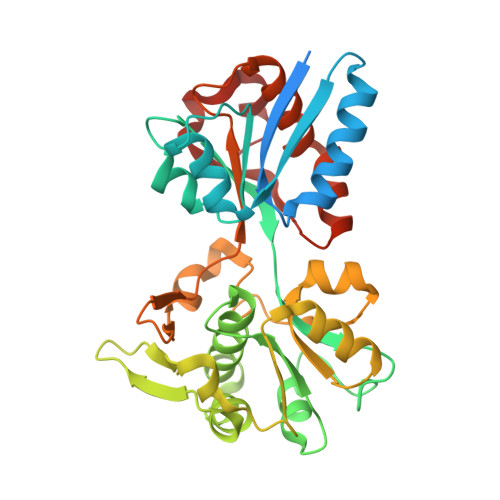Apo and ligand-bound structures of ModA from the archaeon Methanosarcina acetivorans
Chan, S., Giuroiu, I., Chernishof, I., Sawaya, M.R., Chiang, J., Gunsalus, R.P., Arbing, M.A., Perry, L.J.(2010) Acta Crystallogr Sect F Struct Biol Cryst Commun 66: 242-250
- PubMed: 20208152
- DOI: https://doi.org/10.1107/S1744309109055158
- Primary Citation of Related Structures:
3K6U, 3K6V, 3K6W, 3K6X - PubMed Abstract:
The trace-element oxyanion molybdate, which is required for the growth of many bacterial and archaeal species, is transported into the cell by an ATP-binding cassette (ABC) transporter superfamily uptake system called ModABC. ModABC consists of the ModA periplasmic solute-binding protein, the integral membrane-transport protein ModB and the ATP-binding and hydrolysis cassette protein ModC. In this study, X-ray crystal structures of ModA from the archaeon Methanosarcina acetivorans (MaModA) have been determined in the apoprotein conformation at 1.95 and 1.69 A resolution and in the molybdate-bound conformation at 2.25 and 2.45 A resolution. The overall domain structure of MaModA is similar to other ModA proteins in that it has a bilobal structure in which two mixed alpha/beta domains are linked by a hinge region. The apo MaModA is the first unliganded archaeal ModA structure to be determined: it exhibits a deep cleft between the two domains and confirms that upon binding ligand one domain is rotated towards the other by a hinge-bending motion, which is consistent with the 'Venus flytrap' model seen for bacterial-type periplasmic binding proteins. In contrast to the bacterial ModA structures, which have tetrahedral coordination of their metal substrates, molybdate-bound MaModA employs octahedral coordination of its substrate like other archaeal ModA proteins.
Organizational Affiliation:
UCLA-DOE Institute for Genomics and Proteomics, University of California at Los Angeles, Los Angeles, CA 90095, USA.















